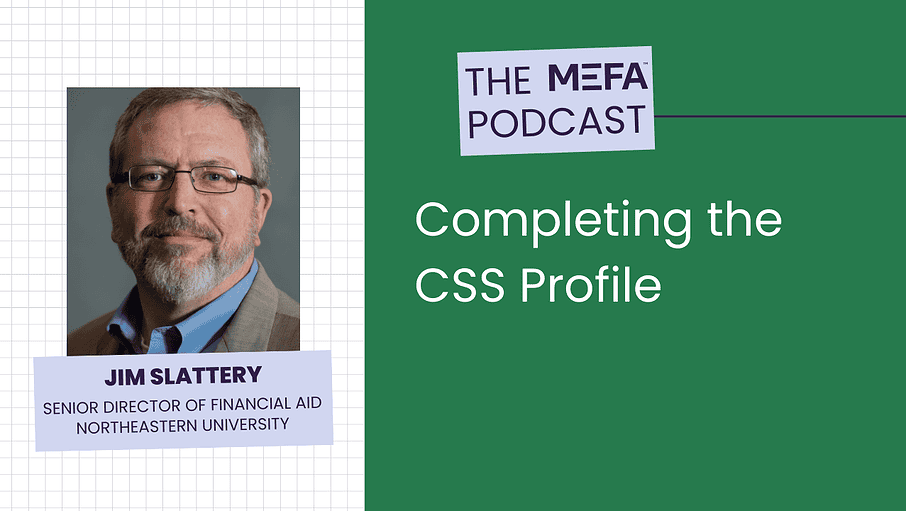

Resources Mentioned in this Episode
Please note that this transcript was auto-generated. We apologize for any minor errors in spelling or grammar.
Jonathan Hughes: Hi everyone. And welcome to the MEFA Podcast. I’m Jonathan Hughes.
Julie Shields-Rutyna: And I’m Julie Shields-Rutyna.
Jonathan Hughes: Hello, Julie, how are you?
Julie Shields-Rutyna: Hi, Jonathan. Great, happy new year. Thank you.
Jonathan Hughes: Happy new year to you. And this is, as you mentioned, our first show of the year, and it’s a great show because we’re going to discuss the other financial aid form today, the CSS profile.
Now we call it the other financial aid form because as you know, you have to file a FAFSA if you want financial aid. And that goes to every college that you’re applying to. Well, in addition to that, some colleges want this CSS Profile to be filed. And this is the financial aid form that wants to know more information from parents.
So it often drives a lot of questions from parents. And so we have a great conversation on the show today. We have a great resource, Jim Slattery, the Senior Director of Financial Aid from Northeastern University is here. And you’ll see, we had a great, great talk. I learned a lot from that conversation and it’s fun and engaging, as Jim always is, so I can’t wait for you to hear. I think you’re going to learn a lot from that conversation.
But first, big student loan news, right Julie?
Julie Shields-Rutyna: Yes. Again. More. So I guess I’ll take people back a little bit, that back in the spring of 2020, the federal government, as part of the COVID relief bill, paused federal student loan repayment.
So if people had federal loans in repayment, they were probably affected and repayment on those loans was paused. So people are not expected to make any payments, and the interest rate on these federal student loans went to zero. So if anyone did make a payment, it was going right to principle and no interest was accruing on the loans. It was really great.
Jonathan Hughes: Yes. I remember them. I used that to my advantage, I actually paid off my loan last year while there was zero interest. So it was something that I really took advantage of. But you mentioned if you had federal loans, they were more than likely affected. So can you actually tell me exactly which loans were affected by this?
Julie Shields-Rutyna: Yes, all Direct Loans, which were Direct Subsidized and Unsubsidized, Stafford Loans for students, and Direct Parent and Graduate PLUS Loans and Direct Consolidation Loans, and then any federally held federal family education loans, and federally held Perkins Loans.
Jonathan Hughes: Okay. So no private loans?
Julie Shields-Rutyna: No private loans are part of this.
So anyway, that pause and 0% interest rate was set to expire January 31st. And so that meant that payments would resume, interest would begin to accrue, in general folks would have to start paying their loans again.
Jonathan Hughes: I remember that too.
Julie Shields-Rutyna: But on December 22nd, President Biden issued a statement announcing that he will extend the pause on federal student loan repayment for an additional 90 days.
So that’s through May 1st. And this is in response to the ongoing pandemic and also to, you know, further strengthen all the economic recovery as a result of the pandemic.
Jonathan Hughes: So the pause continues. So that’s the headline, repayment presumes in May. I did see that. And we’ll link to the statement, the MEFA statement that you just alluded to, in the show notes.
If you are a borrower though, who is getting ready to resume repayment at the end of January, and you’re looking ahead to that May 1st date, what can you do?
Julie Shields-Rutyna: Well, you know, a few things. I think it’s important to know that you can still make payments, even though there is a pause. And in fact, if you do, it could be a good idea to do so because the interest rate is zero.
So every single payment you make is going right to the principal, which is going to allow you to pay down your loan faster. But still, you have the pause. Maybe people don’t want to do that. And that makes sense. But I would recommend that people use this time to make a plan knowing that repayment will begin on May 1st.
So take a look at your budget, a good thing to do in the new year anyway, and just make sure that, you know, that you’ll have that, you’ll be able to start repaying when it comes time to repay. One other thing people could do is just use this time to get in touch with your loan servicer. That’s the agency or the company that’s that is collecting, and that you would pay your loan to, and just make sure they have your correct contact information.
You know, it’s been a long time. People have moved, new phone numbers, addresses. So you just want to make sure that your loan servicers always have your correct contact information so that they can get in touch with you and you receive that communication.
Jonathan Hughes: Okay. And what if you don’t know who your servicer is?
Julie Shields-Rutyna: Yeah, that’s a great question. So if you don’t know who your servicer is, you can log on to the federal student aid website, which is studentaid.gov/coronavirus. And so MEFA always advises, you know, consumers to visit studentaid.gov anyway, and now with that slash coronavirus, you can get further information and updates, and that will all be in the show notes, I’m sure.
But anyone can go in, log in, and find out information about your loan and your servicer. And in fact, that website has a whole lot of other resources that borrowers and people who are repaying their loans should explore.
Jonathan Hughes: Okay. And what are some of those resources?
Julie Shields-Rutyna: Well, one of the great things is on that site, you can explore the various repayment options that may be available to you.
So anyone whose financial situation may have changed, maybe they want to lower their monthly payment or just find out what’s the lowest payment possible, or what would help you repay your loan the fastest. Also information about public service loan forgiveness options. So you can actually go in there and explore all of those different options and you can actually apply for income driven repayment plans right from there. Lots of frequently asked questions and links to a lot of sites.
So I would encourage borrowers who have been affected by this, don’t rest on it too long, use this time and kind of get a jump on it. When we thought that this was going to end in January, we were a little nervous about everyone calling at the same time and trying to figure this out.
So now you have an extra 90 days. So just this would be a good time to do this in a more leisurely way.
Jonathan Hughes: Okay. Good idea. Now, is there anything else before we wrap it up?
Julie Shields-Rutyna: Well, I guess just know that in addition to those federal resources on that site and with your servicer, there are organizations like MEFA, who are always available to help you as well.
So know that and do be aware that there are some reports of loan scams targeting students. So just be a little bit cautious of that. And we wrote a blog about that. So maybe you could put that in the show notes as well.
Jonathan Hughes: We’ll certainly do that. Well, thank you so much Julie. And now we are going to head to the MEFA Mailbag.
And these are questions that have come in from customers over the past few weeks or so, and answered by our college guidance experts. Now, remember if you have any questions, you can please reach out to us at [email protected] or call us at 1-800-449-MEFA. Oh you can also reach us on social media on Facebook and Twitter @mefatweets and Instagram at mefa_ma.
So today’s question comes to us from Robin and she writes, I’m trying to understand more about a student’s income and how it impacts their financial aid for college. My son is a junior in high school and can start co-op next term. So if my son participates in co-op, is that money going to reduce his financial aid or is it exempt like a college work study?
So, Julie, I’m wondering if you could explain what co-op is first and then to answer the question.
Julie Shields-Rutyna: Yes. And what a great question. So co-op is a program that many colleges have here in Massachusetts. The college that is, I think, most well known for co-op programs is Northeastern University, because they have had a co-op program for many years.
And that is where students go to college and during certain semesters they take academic classes, and during other semesters, they go out and work full-time at a real job. And it sometimes can lengthen their time to degree, but when they graduate, they have four or five real work experiences in different settings.
So as you can imagine, there are so many benefits to that, but the money piece is a good question. So what I will also say, another benefit is sometimes students earn a significant amount of money at these jobs, which is wonderful. But Robin’s question is a good one. So when applying for financial aid, student income is considered as one of the factors in determining financial aid. And in general, student income is counted in the financial aid process that any amount of a student’s income that this year that’s over $6,800 is counted at 50%.
In other words, if a student earns over that, 50% of it is expected to be used toward paying for college. However, co-op is exempt from that income rule. Co-op and work study, because those are programs that are, you know, that the student is doing as part of their academic program in part of their financial aid, that income is not counted, it is exempt.
Jonathan Hughes: I didn’t know that. And it’s funny. I wish I had this question earlier. I asked Jim in our interview about it since he’s here from Northeastern, but yeah, how funny, how that works out.
Jonathan Hughes: All right. Remember if you have any questions you can call us up at 1-800-449-MEFA or email us at [email protected]. We have a bench of college guidance experts ready to answer your questions. Now let’s go to my talk with Senior Director of Financial Aid at Northeastern University, Jim Slattery.
Jim Slattery is the Senior Director of Financial Aid at Northeastern University. He’s also a MEFA college financing presenter and has held positions at American Student Assistance and the College Board. Now it’s fitting that he’s worked with the College Board, as we’re here to discuss the CSS Profile, which they administer. And of course, Northeastern University is one among the many colleges and universities that require a CSS Profile to be filed by incoming students in order to receive institutional aid.
So Jim, thank you for joining me.
Jim Slattery: Thank you for having me. Thank you.
Jonathan Hughes: So if we can start right away. Just what is the CSS Profile and why do some colleges want it to be filed along with the FAFSA?
Jim Slattery: Sure. So if we start with a baseline, first of the FAFSA itself, Free Application for Federal Student Aid. I’m presuming your audience has heard of the FAFSA if they’re watching the profile session today. They know something about the FAFSA, but for quick review, the FAFSA is the form required by all colleges administering federal financial aid. It’s used to evaluate eligibility for federal aid, and most state programs and many institutional programs.
Standardized form, you can complete it once it can be sent to multiple schools if you’re a first time applicant. It’s sent to your school on repeated years as you’re in college. That’s the FAFSA quickly. The FAFSA has been around for many years. It’s had different iterations. I’m an old man, many years ago it was the FAF, simply the Financial Aid Form.
As we’ve progressed, Congress, which controls the FAFSA and the FAFSA process, is trying to simplify the form. They’ve made it shorter. They’ve made the instructions better. Believe it or not. For those of you who’ve never done the process and you’re afraid of it, it’s a way better process than it was even several years ago, and certainly 20 and 30 years ago.
It’s all online now. There are great, there’s skip logic involved in the form. A much improved process. That’s all good news. And it’s good news for families who are intimidated by this process, for first-generation families, for families who are reluctant to give strangers their financial info, and so it makes sense.
On the other hand, we have this paradox where college costs are rising. And for many of the most expensive colleges, those colleges are putting, are devoting significant resources to supporting families through financial aid. And when I say significant, I mean it. Tens of millions, in some cases hundreds of millions of dollars. There are many colleges now with a several hundred million dollar financial aid budget annually.
Okay. Lots of money. And you can imagine then with so much money devoted to this, there’s a lot of scrutiny. If you’re a trustee, if you’re a college administrator, and you have these offices, especially with crazy people like me administering them. And there had been administering several hundred million dollars. You want good information, detailed information. That’s where the Profile comes into play.
Now in between, I’ll explain. So if you think of this organically and you say, okay, the FAFSA doesn’t give us enough information. It’s a wonderful brief form that I need more information. I have different ways to get at that. One is to create my own application.
And that is a way to get supplemental information. Now, the downside to that is for first-time applicants, you would now have a process where, Mary Smith completes the FAFSA, and then she’s completing a financial aid application for potentially 5, 10, a number of individual colleges and universities.
And they’re all a little bit different. So many colleges then over time, through coordinated effort with the College Board, which is as an aside, it’s a membership organization. So College Board, they’re the same people who administer the SAT® and the PSAT/NMSQT®. The primary point here is that they’re a membership organization.
And these members then gather and say, if we’re going to have a second form, at least we can have one. Right. So we can have a consistent process. We’re going to require that families fill out something in addition to the FAFSA. We recognize that that could be a pain. We recognize that might be a burden for some of them, but at least minimize it by having something consistent, a single form they can send in that second form, that form can send results to multiple institutions like the FAFSA and at least they minimize this extra burden.
Jonathan Hughes: Can you go a little bit more specific into what exactly are the differences between the Profile and the FAFSA?
Jim Slattery: The profile asks for more information, for more detailed information than the FAFSA. It pretty much asked for everything on the FAFSA and then some. And then corresponding with that, there’s a different methodology and the different base analysis for analyzing this information. The big differences, I’ll mention three, there are many more, several differences. But I’d say there are three big differences.
One is the Profile form asks for the value of one’s home and the debt on the home in order to determine home equity. The FAFSA doesn’t ask any questions about home equity.
Why does the Profile do this? Any economist, anybody involved in financial aid need analysis, determining eligibility to pay, and so on would argue all assets, including the value of your home, impact your ability to pay for college. Right? All things equal. If you have a neighbor, same income, same family size and so on, and you have a ton of money invested in your home and they have nothing invested in their home, you’re probably better off. Do you need to sell your home to pay for college? No. And nobody’s implying that. But does it have some impact on your ability to pay for college? Sure. Most private colleges that use Profile want that information. It makes sense. The only thing I’ll add to that for the audiences and when you hear that people freak out and they hear the stories, like I have to sell my home, or they’re going to presume the entire value of my home. As an aside, Profile for all assets, including home equity, presumes only very small percentages of any of those assets.
So even including home equity in the calculations, doesn’t have this outsized effect that some people hear about or some people talk about or your friends talk about. So I want to put that aside, but that’s one major difference.
Second major difference. The profile process involves the custodial, the non-custodial parent, excuse me. So FAFSA requires only the custodial parent complete the form. The Profile process says, Hey, if both biological parents are involved with the student, it makes sense that they both have some responsibility in helping the student pay for college. And therefore we’re going to request information from both.
Again, I think it sort of makes sense if you’ve talked about it organically. So the Profile process asks for information for both. Another big difference, at least on paper, is that the profile form asks for information about the family retirement assets. The FAFSA form does not request any information about retirement assets.
Now, ironically, although the Profile form collects that information, the base analysis for Profile in any college I’m familiar with, including my own college, doesn’t use those retirement assets in evaluating eligibility for aid. So I want to put people at ease. If they hear me talk about it today, or they see on the form, retirement assets and are like, wait a second, I invested all this money in my 401k, are they going to go after that? I don’t know of any institution that uses that information as part of their evaluation. But it is collected.
Jonathan Hughes: One of the things that I hear from parents a lot too, is that I think that there’s a suspicion that since more is being asked from them, this means that they’re going to get less aid from a college that wants the Profile. Can you speak to that a little bit?
Jim Slattery: One of the things I can say with confidence is, the more a financial aid professional knows about a family, the more college knows about the family, the better off you are. Where people get hurt in this process is when either they slipped through the cracks among millions of financial aid applicants or college applicants, when a college doesn’t know about personal circumstances, a unique circumstances when we’re dealing with standardized forms. So the first part is, it’s a little bit of a trust me, the more we know about you, the better off you are.
That’s the first piece. The second piece though, is a little bit born in some fact in history. There was a point where the base analysis for profile versus the base analysis for FAFSA, the Profile almost always came up with a higher contribution. Which means a higher contribution from the family translates to less eligibility for financial aid. Right?
So the first piece is though, that’s a little misleading because at this point we’re only talking eligibility, all of this has to translate to dollars, right? So we could in theory, find a process that makes you super eligible for aid. But if a college or the government or states don’t have the money to give you, that’s not a very valuable measure. Right? That’s the first part.
Second part is a number of years ago, time slips by for me, but it could be 10 years or more. The College Board and these participating institutions made a lot of revisions to the profile process and the analysis involved in profile. And now, I think the national number, I think fully 40% of applications through the profile process actually show a lower contribution and more eligibility than the FAFSA form.
Jonathan Hughes: There are some aspects of the profile that families may actually find easier to work with than the FAFSA. And I’m thinking about the ability to list special circumstances.
Jim Slattery: So yes, the Profile offers more detailed information, which I already alluded to is a good thing.
But the Profile also has a free form, which you’re alluding to where it says, tell us about special circumstances. We acknowledged that this is a standardized form and you may not be a standardized family. So what’s different about you or what has changed recently about you? What circumstances do you experience that aren’t obvious on this form.
Families that are taking care of elderly parents, who are taking care of children or family members with sickness and crazy medical expenses and so on. The Profile gives you the chance to list that information. Now, the only thing I’ll add to that, use that, think of that as a flag and a starting point.
I would urge families not to think of that as a solution. What do I mean? If you really have crazy circumstances. It’s not crazy, but special circumstances that should be brought to the attention of the college. Get in touch with them individually.
Jonathan Hughes: How does a non-custodial parent file a Profile? Because there are questions sometimes where there are divorced or separated parents, they want to keep their information separate. And then finally, if it’s a situation where there’s no contact. Are there workarounds for that?
Jim Slattery: First of all, the overall Profile process is very secure. It’s very technologically advanced. Colleges are under the obligation to honor privacy. There are very strict laws, similar to the HIPAA laws in the medical community that colleges have to adhere to through this whole process. So that’s a first general part of the response.
Second part of the response is College Board for non-custodial parents process that form as a separate information string. Now, one thing for parents to get used to, especially if your son or daughter is a first time applicant, by the time they were freshmen, they’re typically 18. Almost all of them are 18. If they’re not 18, they’re turning 18 very soon. And so colleges look at them as an adult and as the primary contact point for that particular college.
So one frustration as an aside, the parents get is, they send them the grades, not me. I pay the bill, they should be sending me the grades, but they don’t. They send the grades to the student. They send financial aid information to the student. So for the custodial parents, yes, the student might end up seeing income and other information.
So if you’re going to be freaked out about that, discuss it before you fill out the forms. But the non-custodial parent, that stream of information is kept separate. The second piece is a more complex question, right? The suggestions of this, if non-custodial parent is involved, the college is going to expect that information.
We have something who say, non-custodial parent is not really involved. We evaluate the form and we see that the custodial parent is receiving child support or alimony. Well that applies some involvement, right? It may be reluctant. It may be court ordered. But that implies some involvement. So virtually all cases where the noncustodial parent is participating through alimony or child support, the college is going to expect information for both parents.
Are there cases where we have applicants say, look, non-custodial parent has been out of the picture for 20 years. I have no idea where he or she is. He or she moved out of the country 20 years ago. We can’t provide the information. We ask for some follow-up information, some detail, in some cases, some documentation, but we don’t push on documentation. And in those cases, the non-custodial parent information will be waived. Right. So, you know, how that is waived an with what frequency, it’s going to depend a little bit on the judgment of the institution, a little bit on the judgment of the person evaluating it, but you know, there’s the old blood from a stone expression. And if the information doesn’t exist, colleges aren’t going to look to force it. That’s not fair to families.
Jonathan Hughes: Also if it’s a non-custodial waiver or if you’re listing special circumstances and you need to continue on that conversation, we always say, you know, for the, in general, just to have documentation, right? Are there any other guidelines that you can give to parents or families?
Jim Slattery: More then documentation is detail. Sometimes families present us information. They present a lot of detail. And most of my colleagues, and I’m an example, we’re not as hung up on the documentation. Some families, for example, on the issue of non-custodial parent get hung up on documentation. And they hear about some of the federal guidelines for documentation. And it talks about letters from a parish priest, or from a doctor or from a social worker and they lead with the letters. Right. For me, the letters aren’t as important. For me, the story is important. The letters I might need later to support the story, but the story is what’s important.
So the most general best advice I can give first is as much detail as possible, as much story as possible. Documentation’s important. Where possible documentation. That’s not a proof thing, but documentation can help provide clarity. So don’t be thinking about it as burden of proof. God, these strangers want all this proof from me, or I have to make my case.
That’s not the issue, the issue is clarity for them, right? They’re trying to piece together a story and they’re trying to piece together information, but in the end, all of this becomes an engagement between the family and the individual colleges, right? It’s a series of one-on-one engagements. And although I said the intent of profile is to maybe simplify the process so you complete one form to multiple places. And now I’m talking about contacting multiple places. If you have special circumstances, that’s really what you should be doing, right? Because all these individual places will be making individual decisions and they all deserve that information.
Jonathan Hughes: I have one more question that’s very specific about the CSS Profile, because it is about a question on the CSS Profile and we get it all the time from parents. And I wonder if you know what it’s going to be. And that is, there’s a question that asks parents to estimate how much they plan and contributing to their student’s education in the upcoming year. And this really bedevils parents, and they’re not sure what to put and they’re looking for guidance to know how to answer this question. So what would you tell them?
Jim Slattery: I’ve been answering that question for many years.
Jonathan Hughes: Did you that was going to be the question?
Jim Slattery: Once you said there’s one question, I felt that was coming. And I’ve been answering it for many years, as I said, and I’m not sure I’ve answered it well yet.
But I’ll give you my best effort. So I can tell you, first of all, that question and the information in that question is not used, it’s not incorporated in any kind of analysis is the first part of my answer. What do I mean by that? Income as part of, eventually this information becomes part of some analysis and there are formula that are used in order to determine eligibility for aid, right? And now this is a big, I’m making it sound like a secret or obscure. It’s not, it’s simply, you can imagine the things that go into the formula. What you make for money makes sense as it goes into a formula, your family size, that makes sense. Cause it impacts your expenses.
How many other children you’ll have in college goes into this, what you have in assets, what you have in the bank. So the first thing I could say definitively is this question, how much are you willing to pay toward college, does not go into any formula. I can promise you. It’s an informational question.
Now so then the appropriate follow-up would be, okay, it’s informational. What the heck do you do with it? Some, in fact, I would say most colleges do nothing with it. People who don’t know me, I’m on a video with you now with strangers and they’re looking and saying, this Slattery guy, I don’t believe him. They have every right to think that, but I can say with certainty that most colleges don’t look at the question or the answer to the question. They don’t use the information in any manner.
It’s ignored. And even colleges that look at it on first pass don’t really look at it. But you still want a better answer than that. I understand. I don’t have a magic wand, no college says, that’s the number you gave me and I’m going to use that number. Nobody does that. But is it used? Yes. I need to be honest.
People are asking and it seems very mysterious. Is it sometimes used? Yes. But it’s used for context. So for college, if there’s a non-custodial parent, I’ll make up examples, that has high income and contributes to the families with child support or alimony and says, I expect to contribute zero to my son or daughter’s education.
That’s not a reason that a college wouldn’t give you financial aid, they would never turn you down for financial aid because of that. But it’s a contextual thing that seems inconsistent with the information. Right. So families worry about that. I get it. Families wonder what’s the magic answer then?
Right? Do I go high? Do I go low? The best I can say is not to get wound up on it for the reasons I just outlined. Most colleges don’t look at it or use it for information only. I would answer it as honestly as you can. And not presume that it’s going to have an impact, or any huge impact on the eligibility for aid cause it will not. But it can provide some context on the margins.
Jonathan Hughes: For further context on the question itself, because this is another question that I get on it. This really refers to how much, it doesn’t or it does it, refer to how much a parent may plan on borrowing, or is it how much they plan to pay out of pocket, or is it just generally speaking how much they plan to contribute?
Jim Slattery: Oh, So I don’t usually hear that twist, so that’s interesting. But it’s intended to mean how much do they plan to contribute in whole. So it would include – so if you thought, okay, I’m truthfully as a parent, I just I’m going through this. And my son is well into his college years now. And at the beginning you do plan a bit, you have discussions, or I hope you do with your children and say, I think I might be able to help you out with this much.
And therefore, if a place costs this, and we can get this much help. I think I could do the difference. Right? I think I can, you know, we’ll use numbers. I think I can probably support you with $20,000 a year and the place you’re looking at places that cost $50,000. So if they can give us $30,000 or help us out with $30,000, I think I can do $20,000, then $20,000 then would be all in. The $20,000, whether I’m planning to borrow that or use current resources or a combination of resources. The question is asking, what do you plan to contribute overall? It’s not asking cash in hand or cash contribution. It’s really, what’s going to be your share. What do you expect can be your share in this endeavor? That’s what it’s intended to be. I can also tell you this, and then I’m being a little flippant, but we might as well be straight forward.
It will also not be, the school says, oh, okay, I’ll give you the difference. They’re going to do their independent analysis, right? So just as they won’t very often use it to hurt you, they’re not going to use it to determine what you get. So it doesn’t work. In the case I gave as an example, I think I can contribute $20,000 and I put $20,000 on the form and the school determines that I can contribute $30,000.
They’re not going to say, oh, they told me $20,000, I’ll use the $20,000. They’re going to use their number, right? And it sounds like I’m being wise about that. I don’t intend to be wise about it, but be realistic for your audience.
Jonathan Hughes: If you have a family or a parent or a student who needs help with their CSS Profile, where would you tell them to seek help?
Jim Slattery: First of all, take advantage of any resources you can. And there are good ones. We know that. But I’ll talk about them. Your high school guidance community, right? The school counselors, they have expertise in this area. They know about the form, they know about the process. They can help you.
If you’re involved with any kind of planning group. There are early college planning groups, the TRIO programs, lots of programs out there that have expertise and can help out families. MEFA, this isn’t a shameless plug. It’s legit. MEFA possesses terrific information. You publish, excuse me, really great information about this process and have great advice for family. You do it in conjunction with the professionals in the community, both at the college level and at the high school level. The staff at MEFA have terrific experience. Take advantage. I’m looking at the families now that you, Jonathan, take advantage of the resources that MEFA posses.
The most important place, however, because it’s where the most expertise is. And it’s where the decision making is. Is the financial aid offices at the colleges. Last thing I can say, avoid the friends, avoid the neighbors, especially avoid the in-laws. I could do an entire standup routine about my family gatherings, holiday gatherings, when I’m with the brothers in law who are all very deep experts in the financial aid process and financial aid determination. Although none of them have worked for a moment in the business, that they are all experts. Avoid those characters, avoid the neighbors, go to the experts, go to your school counselor, go to MEFA, go to the financial aid offices.
Jonathan Hughes: Perfectly put as usual and maybe next time we’ll have you on to do that routine on your financial aid expert in laws. But that was great. I appreciate it so much, Jim. Thank you so much.
Jim Slattery: My pleasure. Good luck to everyone.
Jonathan Hughes: All right. Well, that is the show everyone. Julie, thank you so much yet again.
Julie Shields-Rutyna: Yes, you’re welcome. Have a great week.
Jonathan Hughes: Remember if you liked the show, please follow us on Spotify, Apple Podcast, or wherever you’re hearing this. And if you enjoyed the podcast, please give us a rating so we can continue to reach more listeners like you. Until next time, thanks everybody.













